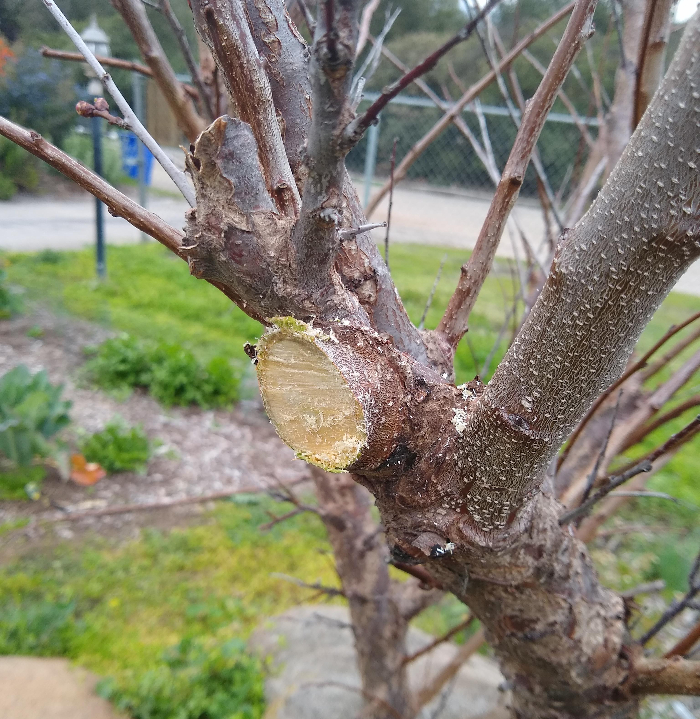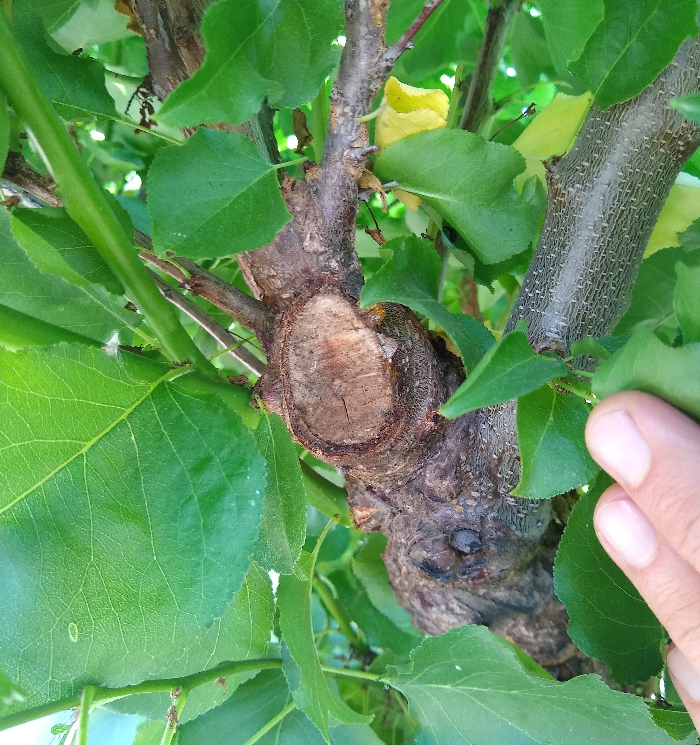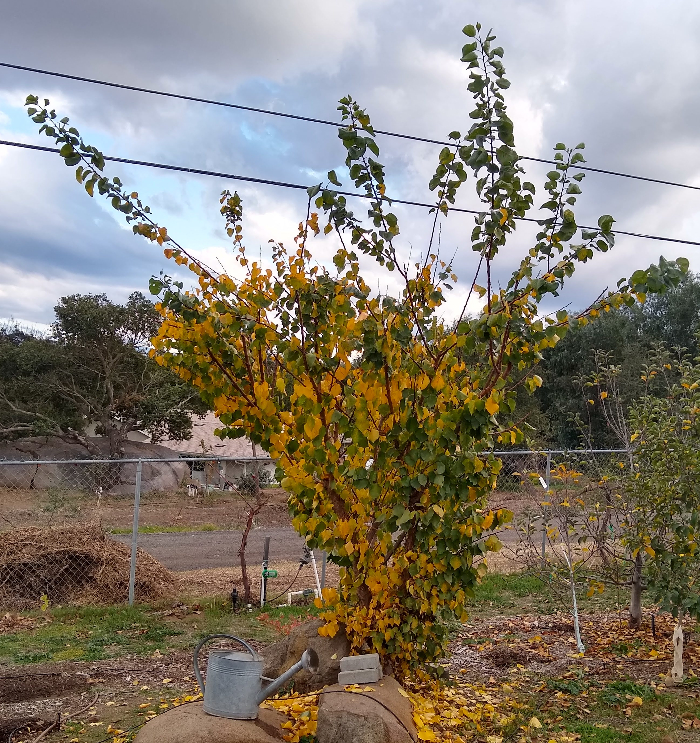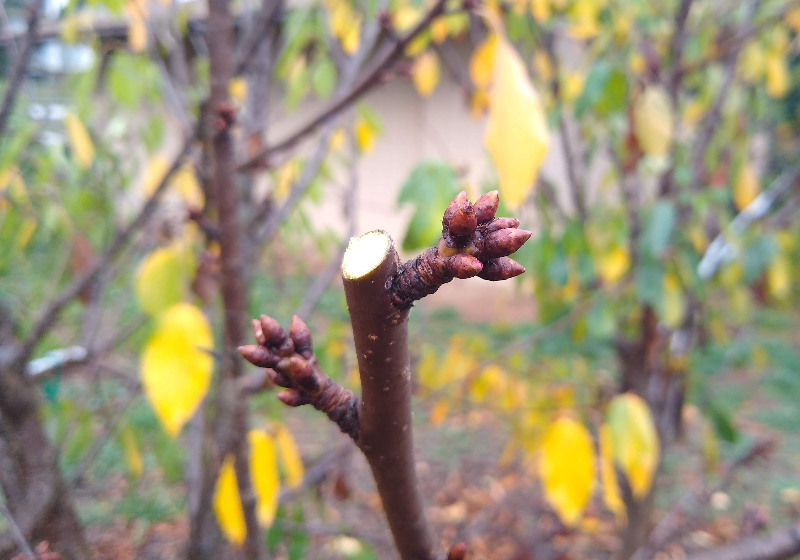“Prune apricots and cherries only during July and August in inland areas and during August near the coast,” reads advice from the University of California. “In grapes, which are commonly pruned during winter, delaying pruning to as late as possible in the dormant season (February or later) reduces the risk of infection.”
Infection from what? A fungus called Eutypa lata is said to enter the trees and vines through pruning cuts. It then causes a disease that is usually referred to as “Eutypa dieback,” where leaves wilt and individual branches suddenly die during the spring and summer. “Eventually the entire plant can be killed.”
I encountered this advice a handful of years ago, after I’d already been pruning apricots, cherries, and grapes throughout fall and winter for many years without seeing any symptoms of dieback. So I continued pruning them as before.
Then a few winters ago, I decided to test things further by pruning at exactly the wrong time: during or just before rain. “Disease organisms infect fresh pruning wounds in the fall and winter when pruning occurs during, or just before, rainfall,” says another page on Eutypa dieback from the University of California.
The results? Still no Eutypa dieback symptoms on my trees and vines: stunted foliage on grapes, cankers and oozing near the pruning wounds on apricots, and single limbs dying.
Why no disease?
Why aren’t my apricots, cherries, and grapes showing Eutypa dieback – whether from all the years of pruning during fall and winter or from the recent cuts made during or just before rain?
One possibility is that my location in the foothills of San Diego County, or Southern California more generally, is not conducive to this fungus and its claimed pathogenicity. In another UC resource, it is implied that Eutypa infection requires more rainfall than we receive. “In wet winter areas” apricots should only be pruned in summer, says this page. Is my yard not wet enough? Studies have found that Eutypa spore production occurs in locations with more than 13.5 inches of rainfall, says this page. I get more than that, but not much more. My average is 15-16 inches.
Another possibility is that the Eutypa infection is still brewing, so to speak, and will exhibit symptoms in due time. “After an initial infection, several growing seasons may elapse before the symptoms of cankers, dieback, and stunted shoots develop.” (From here.)




A third possibility is that the irrigation and fertilization that I provide for my apricots and cherries and grapes is too good. “Hosts stressed from drought or other poor growing conditions appear more extensively affected by this disease.”
Maybe my results are some combination of the above, plus other factors I’m not aware of. Does the Eutypa lata fungus even exist in Southern California? All studies I’ve seen that claim to identify it are in commercial apricot, cherry, and grape growing regions up north, such as Santa Clara County.
A challenge for me in getting a better understanding is the lack of citations in most of the resources. How do they know all of these things? They mostly don’t say.
The eyeball test
So I continue to apply the eyeball test and base my pruning practices upon what I’ve seen with my own two eyes. I am pruning my apricots, cherries, and grapes this winter. I’ve already pruned some; I’ll finish pruning others in January and February.
And it’s raining today, so I went out in the wet and made a few cuts to see if I can induce any disease there.

I’m not trying to kill my trees, but if Eutypa dieback is a disease that occurs in Southern California I want to see the proof, and I expect to see it before too long.
All of my Yard Posts are linked here.
Supporters keep my Yard Posts coming and free of ads. Thank you, Supporters. You can become one if you’re not already.




As we used to say, “Take it easy, greasy, there’s a fungus among us.” Just read an article that pruning to control bougainvillea should take place late in winter. Otherwise, it stimulates more growth.
A relief to read this; I just pruned my stone fruit and figs right before rain this week!
Hi Greg,
A while ago I consulted with you on growing Avacados and it’s nice to reconnect with you. I have been pruning my young cherry, and apricot during winter for the last three years and have not seen that fungus either !
That said, do you think time of pruning how much affects flowering and production?
Last year my cherry produced more than this year and apricot had a couple of flowers and all dropped! I pruned apricot way early in November and we may have over pruned the cherry. Thanks.
After reading Greg’s pruning period recommendations, it appears I missed my apricot tree’s pruning window!
(Today is 1/3/25) our tree has vertical branches over 10 feet long! Should I just wait until late summer for the next pruning period, or is there something that can be done now?
Michael of Ojai
Hi Michael,
I would prune your apricot now if I were you. I’m about to prune mine too. I still haven’t seen any evidence that dieback occurs, or occurs more often, from pruning during winter — not to mention that this winter is very dry currently. I continue to prune all of my grapes, apricots, and cherries in winter, sometimes deliberately during a rain, and have yet to see dieback. Your climate in Ojai is similar to mine in Ramona.